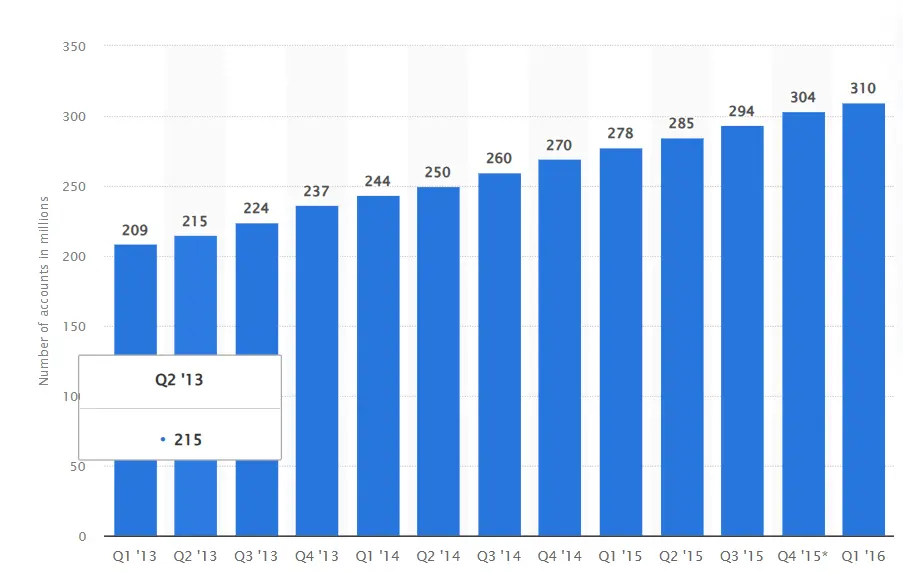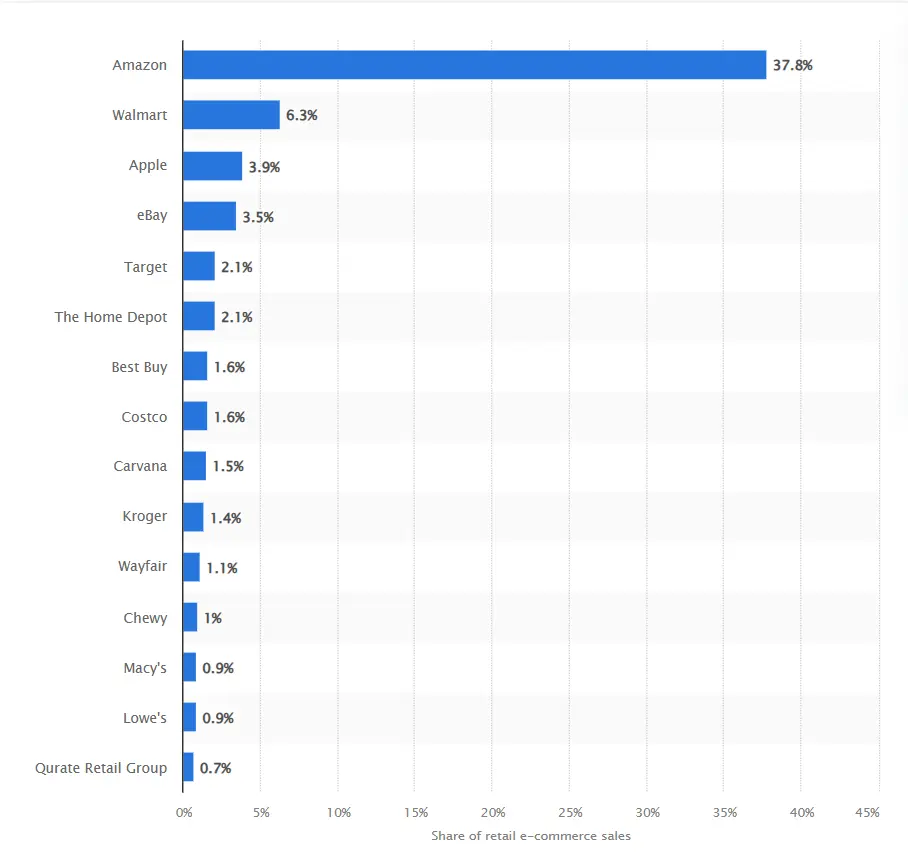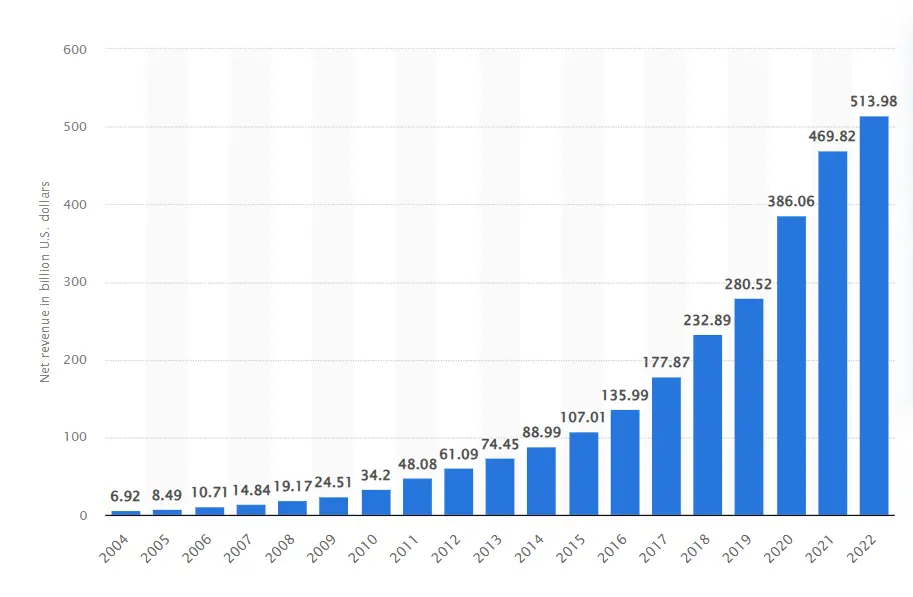Amazon is a globally recognized brand and the third largest by revenue. It was the fourth tech business to achieve $1 trillion and a leader in e-commerce, cloud, advertising, video streaming, and music streaming. Amazon began as an online bookshop in 1995 and a brokerage for other vendors, like eBay. Jeff Bezos always wanted it to be an “everything store” and soon added more things to the e-commerce platform.
Amazon established its own distribution hubs by the 2000s, but it didn’t launch its own delivery services until later. AWS, developed in the early 2000s to assist third-party retailers construct websites fast, was also launched.
With over 30% market share, it is now the largest cloud computing company. Amazon sought additional revenue streams as its e-commerce platform grew. The coronavirus outbreak boosted Amazon sales worldwide. We gathered Amazon statistics. See below for more.

Source
Active users on Amazon’s platform are individuals who have made at least one purchase or transaction within the past 12 months. According to The Tech Report, as of 2024, Amazon boasts a whopping 310 million active users worldwide, solidifying its position as one of the leading e-commerce platforms globally. In comparison, eBay recorded 187 million active buyers, while Walmart had 130 million active customers in 2020.
It is worth noting that Amazon’s active user base has experienced consistent growth over the years, climbing from 69 million in 2007 to 164 million in 2014 and reaching an impressive milestone of 237 million in 2017.

Source
As of June of 2022, 37.8 percent of all retail e-commerce sales were made on Amazon.com. With such a significant market share, it’s clear that Amazon rules the roost in online sales within the United States. Runners-up in the e-commerce industry are Walmart (6.3%), Apple (3.9%), and eBay (3.5%). Amazon’s huge lead in market share establishes a standard from which competitors beyond the year 2024 will have to compete.
These findings match Similarweb’s U.S. web traffic metrics ranking of major e-commerce companies. Amazon tops this list again. However, eBay ranks second, followed by Walmart, Max, and Etsy, confirming Amazon’s dominance in digital commerce.
According to eMarketer, Amazon is poised for growth. After Carvana, Chewy, and Walmart, Amazon is predicted to rank fourth in U.S. retail sales growth at 9.9% in 2024. With an even higher growth rate of 11.7%, Amazon is projected to take second place in this sector in 2024, behind Carvana. These estimates highlight Amazon’s tenacity and potential to revolutionize the retail industry in the United States.

Source
Revenue refers to the monetary value generated by a company through the sale of its goods and services before considering any expenses or taxes. According to Statista, Amazon achieved a global revenue of $513 billion in 2022, positioning it as the third largest company in terms of revenue worldwide.
This places Amazon behind Walmart ($559 billion) and Apple ($574 billion). Over the years, Amazon’s revenue has displayed consistent growth: from $34 billion in 2010 to $136 billion in 2016, and further escalating to $281 billion in 2019.
Net income is a crucial financial measure that reveals a company’s earnings or losses after deducting expenses and taxes from its revenue. Surprisingly, Amazon, the global e-commerce leader, reported a net loss of $2.7 billion for the fiscal year 2022. This marked a significant departure from Amazon’s trend of annual net profitability since 2015 when they had incurred a loss of $241 million.
Multiple factors contributed to Amazon’s financial loss in 2022. The year-long COVID-19 pandemic placed a strain on the company’s logistics and operating costs, impacting its profitability. Moreover, antitrust litigation and regulatory fines across different markets significantly hindered Amazon’s financial performance. Additionally, the company’s ambitious acquisitions and expansions into new sectors and locations introduced complexity to its financial equation, resulting in short-term losses despite the potential for future rewards.
In 2022, Amazon experienced a net loss due to a combination of challenges and strategic choices in an ever-evolving global economic landscape.

Source
In 2024, the worldwide number of Amazon Prime members reached an impressive 220 million. This remarkable figure solidifies Amazon Prime’s global supremacy and its ability to allure and retain a substantial customer base.
In the same year, Netflix reported having 215 million paid subscribers, solidifying its position as a dominant force in digital streaming. On the other hand, Spotify boasts 165 million paying subscribers for its music streaming platform.
Amazon Prime’s subscriber count has grown from 25 million in 2013 to 100 million in 2018 and is projected to reach an impressive 200 million by 2021. This consistent growth highlights Amazon’s dedication to enhancing the perks of Prime and staying at the forefront of the subscription service market.
Shipments refer to the number of packages transported by a company to its customers or partners, either utilizing its own delivery networks or relying on third-party logistics. In 2020, Amazon accomplished a staggering feat by shipping over 7 billion packages worldwide, solidifying its position as one of the foremost e-commerce delivery giants globally.
By comparison, FedEx handled 6.3 billion shipments while UPS processed 5.5 billion packages during the same period. It is worth noting that Amazon’s shipment volume has witnessed a remarkable surge in recent years, skyrocketing from 608 million in 2013 to an astonishing 5 billion in 2019.
If you are an e-commerce seller, an entrepreneur, or a marketer, you may be curious about leveraging Amazon statistics to propel your own business in the world of online commerce. Undoubtedly, Amazon stands as the trailblazer and pioneer of this industry. Delving into its strategies and performance can equip you with valuable insights and ignite inspiration for enhancing your very own venture.
Analyzing Amazon’s market share and revenue growth in different markets and segments can be a valuable tool for growing your e-commerce business. By identifying opportunities and challenges in these markets, you can make informed decisions on entering or expanding your presence.
For instance, markets like India or Brazil with high market share and revenue growth might seem tempting, but considering factors like competition and regulations is crucial before making any moves.
To grow your e-commerce business using Amazon statistics, consider studying Amazon’s pricing and delivery strategies. By analyzing their approaches, you can optimize your own pricing and delivery methods to attract and retain customers. One approach is implementing dynamic pricing algorithms that adjust prices based on factors like demand, supply, and competitor prices.
Additionally, offering free and fast shipping options or partnering with third-party logistics providers can enhance your delivery efficiency and accuracy. These tactics align with Amazon’s successful strategies.
One way to leverage Amazon’s statistics for growing your e-commerce business is by studying their customer service and loyalty programs. By analyzing these programs, you can enhance your own strategies to boost customer satisfaction and retention. For instance, consider implementing a flexible return policy that allows easy product exchanges or refunds.
Additionally, designing a premium membership program with exclusive benefits like discounts, free shipping, and access to special content can further engage your customers and foster loyalty.
Amazon’s diverse diversification and expansion approach can help your e-commerce business expand using statistical insights. This involves learning how to expand your firm across industries and locations. Use your core talents and assets to introduce new products or services that complement your current offers.
This could include cloud computing, digital advertising, and digital content. Acquisitions of enterprises with valuable assets, advanced technologies, a large client base, or service-oriented organizations can also be strategic expansion avenues.
E-commerce companies may innovate, expand, and survive in a changing industry by adopting and adapting Amazon’s diversified strategy. This proactive approach lets companies capitalize on their strengths and unlock latent potential, fostering sustained growth.
Amazon, a remarkable company, has revolutionized the e-commerce industry and more. It has achieved impressive growth and innovation across various domains like online retail, cloud computing, digital content, and artificial intelligence. These statistics demonstrate Amazon’s dominance in the e-commerce market while creating significant value for its customers, partners, and shareholders.
To explore Amazon further or make purchases through its platform, one can simply visit the official website. Additionally, a free trial of Prime is available for those interested in experiencing the advantages of complimentary shipping, video streaming, and more.
Popular statistics –
The post Amazon Statistics: How the E-Commerce Giant Dominates the Market in 2024 appeared first on Digital Marketing Services.
Amazon established its own distribution hubs by the 2000s, but it didn’t launch its own delivery services until later. AWS, developed in the early 2000s to assist third-party retailers construct websites fast, was also launched.
With over 30% market share, it is now the largest cloud computing company. Amazon sought additional revenue streams as its e-commerce platform grew. The coronavirus outbreak boosted Amazon sales worldwide. We gathered Amazon statistics. See below for more.
Highlights
- Amazon, a global e-commerce and technology powerhouse, achieved a whopping $513 billion in fiscal year 2022. This extraordinary feat positions Amazon as the third largest company globally.
- Despite phenomenal revenue growth, the company experienced an unexpected setback with a net loss of $2.7 billion for the year.
- Adding to its prominence, Amazon Prime boasts an impressive customer base of 220 million subscribers worldwide. In the United States alone, 168 million individuals rely on this subscription service for expedited shipping, access to an extensive digital content library, and exclusive discounts
- Amazon’s digital entertainment venture has also been successful. Amazon’s streaming program, Prime Video, had 190 million users in 2022, demonstrating its growing appeal as a digital streaming competitor.
- Amazon’s music streaming service, Prime Music, achieved 74 million members, strengthening its position in the ever-changing digital media sector.
1. Total 220 Million Active Visitors in 2024

Source
Active users on Amazon’s platform are individuals who have made at least one purchase or transaction within the past 12 months. According to The Tech Report, as of 2024, Amazon boasts a whopping 310 million active users worldwide, solidifying its position as one of the leading e-commerce platforms globally. In comparison, eBay recorded 187 million active buyers, while Walmart had 130 million active customers in 2020.
It is worth noting that Amazon’s active user base has experienced consistent growth over the years, climbing from 69 million in 2007 to 164 million in 2014 and reaching an impressive milestone of 237 million in 2017.
2. Amazon Still Dominates Retail E-Commerce With 37.8% Market Share

Source
As of June of 2022, 37.8 percent of all retail e-commerce sales were made on Amazon.com. With such a significant market share, it’s clear that Amazon rules the roost in online sales within the United States. Runners-up in the e-commerce industry are Walmart (6.3%), Apple (3.9%), and eBay (3.5%). Amazon’s huge lead in market share establishes a standard from which competitors beyond the year 2024 will have to compete.
These findings match Similarweb’s U.S. web traffic metrics ranking of major e-commerce companies. Amazon tops this list again. However, eBay ranks second, followed by Walmart, Max, and Etsy, confirming Amazon’s dominance in digital commerce.
According to eMarketer, Amazon is poised for growth. After Carvana, Chewy, and Walmart, Amazon is predicted to rank fourth in U.S. retail sales growth at 9.9% in 2024. With an even higher growth rate of 11.7%, Amazon is projected to take second place in this sector in 2024, behind Carvana. These estimates highlight Amazon’s tenacity and potential to revolutionize the retail industry in the United States.
3. Generated $513 billion in revenue in 2022

Source
Revenue refers to the monetary value generated by a company through the sale of its goods and services before considering any expenses or taxes. According to Statista, Amazon achieved a global revenue of $513 billion in 2022, positioning it as the third largest company in terms of revenue worldwide.
This places Amazon behind Walmart ($559 billion) and Apple ($574 billion). Over the years, Amazon’s revenue has displayed consistent growth: from $34 billion in 2010 to $136 billion in 2016, and further escalating to $281 billion in 2019.
4. Reported a net loss of $2.7 billion in 2022
Net income is a crucial financial measure that reveals a company’s earnings or losses after deducting expenses and taxes from its revenue. Surprisingly, Amazon, the global e-commerce leader, reported a net loss of $2.7 billion for the fiscal year 2022. This marked a significant departure from Amazon’s trend of annual net profitability since 2015 when they had incurred a loss of $241 million.
Multiple factors contributed to Amazon’s financial loss in 2022. The year-long COVID-19 pandemic placed a strain on the company’s logistics and operating costs, impacting its profitability. Moreover, antitrust litigation and regulatory fines across different markets significantly hindered Amazon’s financial performance. Additionally, the company’s ambitious acquisitions and expansions into new sectors and locations introduced complexity to its financial equation, resulting in short-term losses despite the potential for future rewards.
In 2022, Amazon experienced a net loss due to a combination of challenges and strategic choices in an ever-evolving global economic landscape.
5. Reaching 220 Million Prime Subscribers Worldwide in 2024
Source
In 2024, the worldwide number of Amazon Prime members reached an impressive 220 million. This remarkable figure solidifies Amazon Prime’s global supremacy and its ability to allure and retain a substantial customer base.
In the same year, Netflix reported having 215 million paid subscribers, solidifying its position as a dominant force in digital streaming. On the other hand, Spotify boasts 165 million paying subscribers for its music streaming platform.
Amazon Prime’s subscriber count has grown from 25 million in 2013 to 100 million in 2018 and is projected to reach an impressive 200 million by 2021. This consistent growth highlights Amazon’s dedication to enhancing the perks of Prime and staying at the forefront of the subscription service market.
6. Shipped over 7 billion packages worldwide in 2020
Shipments refer to the number of packages transported by a company to its customers or partners, either utilizing its own delivery networks or relying on third-party logistics. In 2020, Amazon accomplished a staggering feat by shipping over 7 billion packages worldwide, solidifying its position as one of the foremost e-commerce delivery giants globally.
By comparison, FedEx handled 6.3 billion shipments while UPS processed 5.5 billion packages during the same period. It is worth noting that Amazon’s shipment volume has witnessed a remarkable surge in recent years, skyrocketing from 608 million in 2013 to an astonishing 5 billion in 2019.
How to Use Amazon Statistics to Grow Your E-Commerce Business
If you are an e-commerce seller, an entrepreneur, or a marketer, you may be curious about leveraging Amazon statistics to propel your own business in the world of online commerce. Undoubtedly, Amazon stands as the trailblazer and pioneer of this industry. Delving into its strategies and performance can equip you with valuable insights and ignite inspiration for enhancing your very own venture.
Analyze Amazon’s Market Share and Revenue Growth
Analyzing Amazon’s market share and revenue growth in different markets and segments can be a valuable tool for growing your e-commerce business. By identifying opportunities and challenges in these markets, you can make informed decisions on entering or expanding your presence.
For instance, markets like India or Brazil with high market share and revenue growth might seem tempting, but considering factors like competition and regulations is crucial before making any moves.
Study Amazon’s Pricing and Delivery Strategies
To grow your e-commerce business using Amazon statistics, consider studying Amazon’s pricing and delivery strategies. By analyzing their approaches, you can optimize your own pricing and delivery methods to attract and retain customers. One approach is implementing dynamic pricing algorithms that adjust prices based on factors like demand, supply, and competitor prices.
Additionally, offering free and fast shipping options or partnering with third-party logistics providers can enhance your delivery efficiency and accuracy. These tactics align with Amazon’s successful strategies.
Learn from Amazon’s Customer Service and Loyalty Programs
One way to leverage Amazon’s statistics for growing your e-commerce business is by studying their customer service and loyalty programs. By analyzing these programs, you can enhance your own strategies to boost customer satisfaction and retention. For instance, consider implementing a flexible return policy that allows easy product exchanges or refunds.
Additionally, designing a premium membership program with exclusive benefits like discounts, free shipping, and access to special content can further engage your customers and foster loyalty.
Explore Amazon’s Diversification and Expansion Strategies
Amazon’s diverse diversification and expansion approach can help your e-commerce business expand using statistical insights. This involves learning how to expand your firm across industries and locations. Use your core talents and assets to introduce new products or services that complement your current offers.
This could include cloud computing, digital advertising, and digital content. Acquisitions of enterprises with valuable assets, advanced technologies, a large client base, or service-oriented organizations can also be strategic expansion avenues.
E-commerce companies may innovate, expand, and survive in a changing industry by adopting and adapting Amazon’s diversified strategy. This proactive approach lets companies capitalize on their strengths and unlock latent potential, fostering sustained growth.
Conclusion
Amazon, a remarkable company, has revolutionized the e-commerce industry and more. It has achieved impressive growth and innovation across various domains like online retail, cloud computing, digital content, and artificial intelligence. These statistics demonstrate Amazon’s dominance in the e-commerce market while creating significant value for its customers, partners, and shareholders.
To explore Amazon further or make purchases through its platform, one can simply visit the official website. Additionally, a free trial of Prime is available for those interested in experiencing the advantages of complimentary shipping, video streaming, and more.
Popular statistics –
- 500+ Social media statistics in 2024
- TikTok Statistics You Must Use in 2024 to Grow Your Business
- 50 Amazing Google Statistics and Facts
- 100+ SEO Statistics For Business and Blog
The post Amazon Statistics: How the E-Commerce Giant Dominates the Market in 2024 appeared first on Digital Marketing Services.
